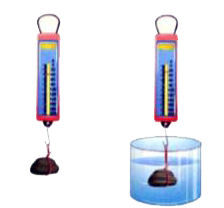A stone is weighed using a spring balance (Fig. C) and it weighs 40 g. But when it is dipped in water, it weighs only around 25 g. Why does it weigh less in water? Which force acting on the stone is responsible for this?

Step by step video & image solution for A stone is weighed using a spring balance (Fig. C) and it weighs 40 g. But when it is dipped in water, it weighs only around 25 g. Why does it weigh less in water? Which force acting on the stone is responsible for this? by Physics experts to help you in doubts & scoring excellent marks in Class 8 exams.
Updated on:21/07/2023Topper's Solved these Questions
- PHYSICAL QUANTITIES AND MEASUREMENT BOOK - ICSECHAPTER - PHYSICAL QUANTITIES AND MEASUREMENT EXERCISE - Exercises (Section II) Numerical questions
11 Videos
- MODEL TEST PAPERS BOOK - ICSECHAPTER - MODEL TEST PAPERS EXERCISE - Model Test Paper 2 (Section II)
42 Videos
- SOUNDBOOK - ICSECHAPTER - SOUNDEXERCISE - Picture Study
4 Videos
Similar Questions
The reading of a spring balance when a mass is weighed on it in air is 40 gm. When the mass is immersed in water, its reading is 20 gm. The specific gravity of the mass is
View SolutionA piece of stone of mass 15.1 g is first immersed in a liquid and it weighs 10.9 gf. Then on immersing the piece of stone in water, it weighs 9.7 gf. Calculate the weight of the piece of stone in air
View SolutionA piece of stone of mass 15.1 g is first immersed in a liquid and it weighs 10.9 gf. Then on immersing the piece of stone in water, it weighs 9.7 gf. Calculate the volume of the piece of stone
View SolutionRead the following statements :
S1 : An object shall weigh more at pole than at equator when weighed by using a physical balance.
S2 : It shall weigh the same at pole and equator when weighed by using a physical balance.
S3 : It shall weigh the same at pole and equator when weighed by using a spring balance.
S4 : It shall weigh more at the pole than at equator when weighed using a spring balance.
Which of the above statements is/are correct ?
View SolutionA piece of stone of mass 15.1 g is first immersed in a liquid and it weighs 10.9 gf. Then on immersing the piece of stone in water, it weighs 9.7 gf. Calculate the relative density of stone
View SolutionA piece of stone of mass 15.1 g is first immersed in a liquid and it weighs 10.9 gf. Then on immersing the piece of stone in water, it weighs 9.7 gf. Calculate the relative density of the liquid.
View SolutionAn empty RD bottle weighs 30.5 g. When completely filled with water, it is found to weigh 60.5 g. When filled with alcohol it is found to weigh 53.5 g. What is the relative density of alcohol?
View SolutionA piece of wax wieghs 18.03 g in air. A piece of metal is found to weigh 17.03 g in water. It is tied to the wax and both together weigh 15.23 g in water. Then, the specific gravity of wax is
View SolutionA body suspended on a spring balance in a ship weighs W0 when the ship is at rest. When the ship begins to move along the equator with a speed v, show that the scale reading is very close to W0(1±2ωV/g), where ω is the angular speed of the earth.
View SolutionA piece of brass (Cu and Zn) weighs 12.9g in air. When completely immersed in water, it weighs 11.3g. Then relative densities of Cu and Zn are 8.9and7.1 respectively. The mass of copper in the alloy is
View Solution
